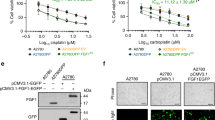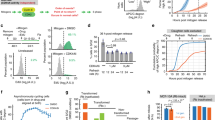Abstract
The retinoblastoma (RB) tumor suppressor has been proposed to function as a key mediator of cell cycle checkpoints induced by chemotherapeutic agents. However, these prior studies have relied on embryonic fibroblasts harboring chronic loss of RB, a condition under which compensation of RB functions is known to occur. Here we utilized primary adult fibroblasts derived from mice harboring loxP sites flanking exon 3 of the Rb gene to delineate the action of RB in the chemotherapeutic response. In this system we find that targeted disruption of Rb leads to little overt change in cell cycle distribution. However, these cells exhibited deregulation of RB/E2F target genes and became aneuploid following culture in the absence of RB. When challenged with both DNA damaging and antimetabolite chemotherapeutics, RB was required for primary adult cells to undergo DNA damage checkpoint responses and loss of RB resulted in enhanced aneuploidy following challenge. In contrast, following spontaneous immortalization and the loss of functional p53 signaling, the antimetabolite 5-fluorouracil (5-FU) failed to induce arrest despite the presence of RB. In these immortal cultures RB/E2F targets were deregulated in a complex, gene-specific manner and RB was required for the checkpoint response to camptothecin (CPT). Mechanistic analyses of the checkpoint responses in primary cells indicated that loss of RB leads to increased p53 signaling and decreased viability following both CPT and 5-FU treatment. However, the mechanism through which these agents act to facilitate cell cycle inhibition through RB were distinct. These studies underscore the critical role of RB in DNA-damage checkpoint signaling and demonstrate that RB mediates chemotherapeutic-induced cell cycle inhibition in adult fibroblasts by distinct mechanisms.
This is a preview of subscription content, access via your institution
Access options
Subscribe to this journal
Receive 50 print issues and online access
$259.00 per year
only $5.18 per issue
Buy this article
- Purchase on Springer Link
- Instant access to full article PDF
Prices may be subject to local taxes which are calculated during checkout







Similar content being viewed by others
References
Agami R and Bernards R . (2000). Cell, 102, 55–66.
Almasan A, Yin Y, Kelly RE, Lee EY, Bradley A, Li W, Bertino JR and Wahl GM . (1995). Proc. Natl. Acad. Sci. USA, 92, 5436–5440.
Angus SP, Wheeler LJ, Ranmal SA, Zhang X, Markey MP, Mathews CK and Knudsen ES . (2002). J. Biol. Chem., 277, 44376–44384.
Appella E and Anderson CW . (2001). Eur. J. Biochem., 268, 2764–2772.
Avni D, Yang H, Martelli F, Hofmann F, ElShamy WM, Ganesan S, Scully R and Livingston DM . (2003). Mol. Cell, 12, 735–746.
Balsitis SJ, Sage J, Duensing S, Munger K, Jacks T and Lambert PF . (2003). Mol. Cell. Biol., 23, 9094–9103.
Banerjee D, Mayer-Kuckuk P, Capiaux G, Budak-Alpdogan T, Gorlick R and Bertino JR . (2002). Biochim. Biophys. Acta, 1587, 164–173.
Banin S, Moyal L, Shieh S, Taya Y, Anderson CW, Chessa L, Smorodinsky NI, Prives C, Reiss Y, Shiloh Y and Ziv Y . (1998). Science, 281, 1674–1677.
Bartek J and Lukas J . (2001). Curr. Opin. Cell. Biol., 13, 738–747.
Bartkova J, Lukas J and Bartek J . (1997). Prog. Cell. Cycle Res., 3, 211–220.
Berkovich E and Ginsberg D . (2003). Oncogene, 22, 161–167.
Brugarolas J, Chandrasekaran C, Gordon JI, Beach D, Jacks T and Hannon GJ . (1995). Nature, 377, 552–557.
Brugarolas J, Moberg K, Boyd SD, Taya Y, Jacks T and Lees JA . (1999). Proc. Natl. Acad. Sci. USA, 96, 1002–1007.
Bunz F, Hwang PM, Torrance C, Waldman T, Zhang Y, Dillehay L, Williams J, Lengauer C, Kinzler KW and Vogelstein B . (1999). J. Clin. Invest., 104, 263–269.
Canman CE, Lim DS, Cimprich KA, Taya Y, Tamai K, Sakaguchi K, Appella E, Kastan MB and Siliciano JD . (1998). Science, 281, 1677–1679.
Clarke AR, Maandag ER, van Roon M, van der Lugt NM, van d V, Hooper ML, Berns A and te RH . (1992). Nature, 359, 328–330.
DeGregori J, Kowalik T and Nevins JR . (1995). Mol. Cell. Biol., 15, 4215–4224.
Demers GW, Foster SA, Halbert CL and Galloway DA . (1994). Proc. Natl. Acad. Sci. USA, 91, 4382–4386.
Deng C, Zhang P, Harper JW, Elledge SJ and Leder P . (1995). Cell, 82, 675–684.
Di Leonardo A, Khan SH, Linke SP, Greco V, Seidita G and Wahl GM . (1997). Cancer Res., 57, 1013–1019.
Dyson N . (1998). Genes Dev., 12, 2245–2262.
el Deiry WS, Tokino T, Velculescu VE, Levy DB, Parsons R, Trent JM, Lin D, Mercer WE, Kinzler KW and Vogelstein B . (1993). Cell, 75, 817–825.
Flatt PM and Pietenpol JA . (2000). Drug Metab. Rev., 32, 283–305.
Guo N, Faller DV and Vaziri C . (2000). J. Biol. Chem., 275, 1715–1722.
Hall M and Peters G . (1996). Adv. Cancer Res., 68, 67–108.
Harbour JW and Dean DC . (2000). Nat. Cell. Biol., 2, E65–E67.
Harbour JW, Lai SL, Whang-Peng J, Gazdar AF, Minna JD and Kaye FJ . (1988). Science, 241, 353–357.
Harbour JW, Luo RX, Dei SA, Postigo AA and Dean DC . (1999). Cell, 98, 859–869.
Harrington EA, Bruce JL, Harlow E and Dyson N . (1998). Proc. Natl. Acad. Sci. USA, 95, 11945–11950.
Hartwell LH and Weinert TA . (1989). Science, 246, 629–634.
Harvey DM and Levine AJ . (1991). Genes Dev., 5, 2375–2385.
Helt AM and Galloway DA . (2003). Carcinogenesis, 24, 159–169.
Herrera RE, Sah VP, Williams BO, Makela TP, Weinberg RA and Jacks T . (1996). Mol. Cell. Biol., 16, 2402–2407.
Horowitz JM, Park SH, Bogenmann E, Cheng JC, Yandell DW, Kaye FJ, Minna JD, Dryja TP and Weinberg RA . (1990). Proc. Natl. Acad. Sci. USA, 87, 2775–2779.
Hurford Jr RK, Cobrinik D, Lee MH and Dyson N . (1997). Genes Dev., 11, 1447–1463.
Jacks T, Fazeli A, Schmitt EM, Bronson RT, Goodell MA and Weinberg RA . (1992). Nature, 359, 295–300.
Kastan MB, Zhan Q, el Deiry WS, Carrier F, Jacks T, Walsh WV, Plunkett BS, Vogelstein Jr B and Fornace AJ . (1992). Cell, 71, 587–597.
Knudsen ES, Buckmaster C, Chen TT, Feramisco JR and Wang JY . (1998). Genes Dev., 12, 2278–2292.
Knudsen KE, Booth D, Naderi S, Sever-Chroneos Z, Fribourg AF, Hunton IC, Feramisco JR, Wang JY and Knudsen ES . (2000). Mol. Cell. Biol., 20, 7751–7763.
Knudsen KE, Fribourg AF, Strobeck MW, Blanchard JM and Knudsen ES . (1999). J. Biol. Chem., 274, 27632–27641.
Knudsen ES and Wang JY . (1997). Mol. Cell. Biol., 17, 5771–5783.
Lam EW and La Thangue NB . (1994). Curr. Opin. Cell. Biol., 6, 859–866.
Lan Z, Sever-Chroneos Z, Strobeck MW, Park CH, Baskaran R, Edelmann W, Leone G and Knudsen ES . (2002). J. Biol. Chem., 277, 8372–8381.
Lee EY, Chang CY, Hu N, Wang YC, Lai CC, Herrup K, Lee WH and Bradley A . (1992). Nature, 359, 288–294.
Lee EY, To H, Shew JY, Bookstein R, Scully P and Lee WH . (1988). Science, 241, 218–221.
Lentini L, Pipitone L and Di Leonardo A . (2002). Neoplasia, 4, 380–387.
Li W, Fan J, Hochhauser D, Banerjee D, Zielinski Z, Almasan A, Yin Y, Kelly R, Wahl GM and Bertino JR . (1995). Proc. Natl. Acad. Sci. USA, 92, 10436–10440.
Longley DB, Boyer J, Allen WL, Latif T, Ferguson PR, Maxwell PJ, McDermott U, Lynch M, Harkin DP and Johnston PG . (2002). Cancer Res., 62, 2644–2649.
Longley DB, Harkin DP and Johnston PG . (2003). Nat. Rev. Cancer, 3, 330–338.
Lundberg AS and Weinberg RA . (1998). Mol. Cell. Biol., 18, 753–761.
MacPherson D, Sage J, Crowley D, Trumpp A, Bronson RT and Jacks T . (2003). Mol. Cell. Biol., 23, 1044–1053.
Mailand N, Falck J, Lukas C, Syljuasen RG, Welcker M, Bartek J and Lukas J . (2000). Science, 288, 1425–1429.
Markey MP, Angus SP, Strobeck MW, Williams SL, Gunawardena RW, Aronow BJ and Knudsen ES . (2002). Cancer Res., 62, 6587–6597.
Meraldi P, Lukas J, Fry AM, Bartek J and Nigg EA . (1999). Nat. Cell. Biol., 1, 88–93.
Mittnacht S . (1998). Curr. Opin. Genet. Dev., 8, 21–27.
Mudrak I, Ogris E, Rotheneder H and Wintersberger E . (1994). Mol. Cell. Biol., 14, 1886–1892.
Muller H, Bracken AP, Vernell R, Moroni MC, Christians F, Grassilli E, Prosperini E, Vigo E, Oliner JD and Helin K . (2001). Genes Dev., 15, 267–285.
Nyberg KA, Michelson RJ, Putnam CW and Weinert TA . (2002). Annu. Rev. Genet., 36, 617–656.
Ogris E, Rotheneder H, Mudrak I, Pichler A and Wintersberger E . (1993). J. Virol., 67, 1765–1771.
Peters GJ, Backus HH, Freemantle S, van Triest B, Codacci-Pisanelli G, van der Wilt CL, Smid K, Lunec J, Calvert AH, Marsh S, McLeod HL, Bloemena E, Meijer S, Jansen G, van Groeningen CJ and Pinedo HM . (2002). Biochim. Biophys. Acta, 1587, 194–205.
Philips A, Huet X, Plet A, Le Cam L, Vie A and Blanchard JM . (1998). Oncogene, 16, 1373–1381.
Polager S, Kalma Y, Berkovich E and Ginsberg D . (2002). Oncogene, 21, 437–446.
Pomerantz J, Schreiber-Agus N, Liegeois NJ, Silverman A, Alland L, Chin L, Potes J, Chen K, Orlow I, Lee HW, Cordon-Cardo C and DePinho RA . (1998). Cell, 92, 713–723.
Ren B, Cam H, Takahashi Y, Volkert T, Terragni J, Young RA and Dynlacht BD . (2002). Genes Dev., 16, 245–256.
Rittling SR and Denhardt DT . (1992). Oncogene, 7, 935–942.
Sage J, Miller AL, Perez-Mancera PA, Wysocki JM and Jacks T . (2003). Nature, 424, 223–228.
Santi DV, McHenry CS and Sommer H . (1974). Biochemistry, 13, 471–481.
Siddiqui H, Solomon DA, Gunawardena RW, Wang Y and Knudsen ES . (2003). Mol. Cell. Biol., 23, 7719–7731.
Slebos RJ, Lee MH, Plunkett BS, Kessis TD, Williams BO, Jacks T, Hedrick L, Kastan MB and Cho KR . (1994). Proc. Natl. Acad. Sci. USA, 91, 5320–5324.
Smith ML, Zhan Q, Bae Jr I and Fornace AJ . (1994). Exp. Cell. Res., 215, 386–389.
Sommer H and Santi DV . (1974). Biochem. Biophys. Res. Commun., 57, 689–695.
Song S, Gulliver GA and Lambert PF . (1998). Proc. Natl. Acad. Sci. USA, 95, 2290–2295.
Stewart ZA and Pietenpol JA . (2001). Chem. Res. Toxicol., 14, 243–263.
Todaro G and Green H . (1963). J. Cell. Biol., 17, 299–313.
Weinberg RA . (1995). Cell, 81, 323–330.
Zhang HS and Dean DC . (2001). Oncogene, 20, 3134–3138.
Zheng L and Lee WH . (2002). Adv. Cancer Res., 85, 13–50.
Acknowledgements
The authors are grateful to Dr Karen Knudsen, Dr Thérèse Tuohy, David Solomon, Christin Petre-Draviam and Emily Bosco for comments on the manuscript and all members of the Knudsen's laboratories for thought provoking discussion. This work was supported by ACS grant RSG-01-254-01-CCG to ESK. TJ is an investigator of the Howard Hughes Medical Institute. CNM is supported by National Cancer Institute Training Grant T32 CA 59268.
Author information
Authors and Affiliations
Corresponding author
Rights and permissions
About this article
Cite this article
Mayhew, C., Perkin, L., Zhang, X. et al. Discrete signaling pathways participate in RB-dependent responses to chemotherapeutic agents. Oncogene 23, 4107–4120 (2004). https://doi.org/10.1038/sj.onc.1207503
Received:
Revised:
Accepted:
Published:
Issue Date:
DOI: https://doi.org/10.1038/sj.onc.1207503
Keywords
This article is cited by
-
Non-canonical functions of the RB protein in cancer
Nature Reviews Cancer (2018)
-
Systematically characterizing and prioritizing chemosensitivity related gene based on Gene Ontology and protein interaction network
BMC Medical Genomics (2012)
-
Tailoring to RB: tumour suppressor status and therapeutic response
Nature Reviews Cancer (2008)
-
Loss of the retinoblastoma tumor suppressor: differential action on transcriptional programs related to cell cycle control and immune function
Oncogene (2007)
-
Repression of intestinal drug metabolizing enzymes by the SV40 large T antigen
Oncogene (2007)



